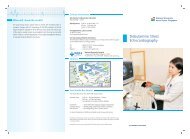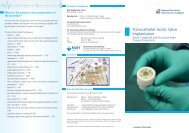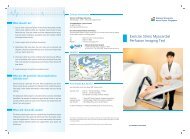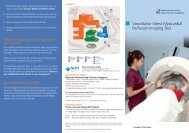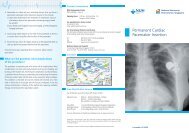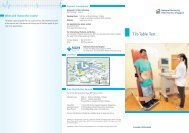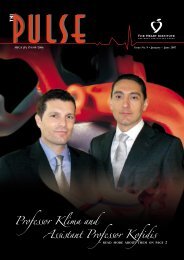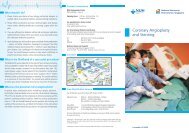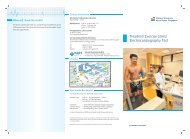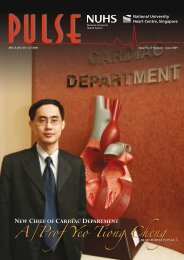2011 July - December - nuhcs
2011 July - December - nuhcs
2011 July - December - nuhcs
- No tags were found...
Create successful ePaper yourself
Turn your PDF publications into a flip-book with our unique Google optimized e-Paper software.
The “Hybrid” operating theatre at NUHCS combines all the features of astandard operating room with state of the art imaging.EVAR and Chimney EVAR. A hybrid procedure aims to combineendovascular procedures with limited open surgery. The stent graftdeployment is performed in combination with an open operationto revascularise selected arteries that will be “covered” by the stentgraft i.e. deprived of arterial inflow. In this method more extensiveEVAR devices can be deployed to treat the primary lesion whilepreserving arterial flow to critical arteries.Thoraco-abdominal aneurysms (TAA) typically involvesuch vessels and deployment of the EVAR device will coverimportant arteries e.g. visceral or renal arteries, resulting inend organ ischaemia which may be critical. The open operationcomponent aims to bring a bypass graft from an artery outsidethe stent graft coverage to vital arteries within the coverageregion. This component adds to the EVAR procedure in time andrisk but is usually judged to be a lesser risk than the traditionalopen thoracoabdominal operation. Another common example isrevascularisation of the left common carotid artery and/or the leftsubclavian artery from the innominate artery or the right commoncarotid artery to allow treatment of a distal arch thoracic aneurysm.Continued design improvement in stent graft including branchedendografts will reduce but not eliminate this type of surgery.“Chimney stents” into the carotid artery with TEVAR intothe proximal aortic arch have recently been described. All suchhybrid procedures aim to reduce the morbidity and mortality oftreating aortic disease in a patient population that is increasinglyolder and less fit than when major open repairs were developedand popularised. Even then, significant risks were accepted in theunderstanding that the large open operation was the only option.Now with hybrid EVAR performed in hybrid OTs, these complexprocedures can be done with much lower risks. The trade off beingthat durability and problems such as ‘endoleaks’ require carefulsurveillance.The Hybrid OR also promises to improve care in lifethreateningemergencies such as aortic dissection or transection.TRANSCATHETER (APICAL / FEMORAL) AORTICVALVE IMPLANTATIONThe transcatheter aortic heart valve integrates balloon-expandablestent technology with a replacement tissue heart valve. NUHCSis one of the few centres in Asia to perform percutaneoustranscatheter aortic valve replacement. During the procedure, acatheter is advanced to the aortic valve, either through the femoralartery or through a small chest incision and through the leftventricle. Once the catheter is in place, a tissue valve with a metalstent scaffolding is positioned and deployed. Flouroscopic guidanceprovides real time visualization. The force of the expanding stentanchors the new valve in place, completely avoiding the needfor sutures, cardiopulmonary bypass, open surgery—and theirassociated effects.ENDOVASCULAR LIMB SALVAGERest pain, tissue loss, and gangrene are manifestations of criticallimb ischemia caused by peripheral arterial disease and define apatient subgroup at highest risk for major limb amputation. Thediagnosis of critical limb ischemia mandates prompt medical andsurgical management to achieve the best chance of limb salvage.Surgical intervention has evolved from primary amputation toopen bypass to the present era of endovascular therapy. The goals ofsurgical bypass and endovascular therapy are to improve perfusionsufficiently to permit healing. Endovascular therapy has beenshown in multiple retrospective studies to achieve limb salvagesimilar to open bypass. AT NUHCS, we are able to achieve a 75%twelve month amputation free survival using an endovascular firstapproach in patients presenting with critical limb ischaemia. Closeclinical surveillance and serial monitoring of limb perfusion bymeans of noninvasive arterial studies are needed to determine theneed for further vascular intervention. Limb salvage patients sufferfrom multiple comorbidities and benefit from a minimally invasiveand multidisciplinary, team approach to care.Combining traditional operations with angiographic imagingtechnology in the same suite promises to transform the care ofpatients, with improved safety and outcomes, while stimulatinginnovation. What previously involved two separate procedurescan now be done in one. When the best approach for a patientinvolves a combination of coronary artery bypass and stenting,by performing both at the same time, we can reduce the stress ofsurgery and improve recovery time. The imaging technology canalso be used after a standard bypass to ensure the bypass graft isproviding adequate blood flow to the heart. Published research hasshown that this approach can reduce the number of complications.All of these imaging technologies are coordinated andpresented to the surgeon through a state of the art large displayLED monitor—an 8Megapixel high definition screen that displayspatient medical information along with reference and live imagesin the OT. The system also allows for videoconferencing in thehospital and permits broadcast of live video for teaching purposes.In conclusion, the potential is for improved patient outcomesand safety is huge, its utilization synergistic and its reachmultidisciplinary. The “Hybrid” operating theatre at NUHCScombines all the features of a standard operating room with stateof the art imaging. It’s a glimpse into the future of surgery and setsa new standard of care for patients with cardiovascular disease.NUHCS PULSE | 7



